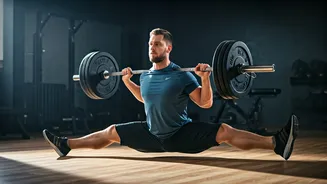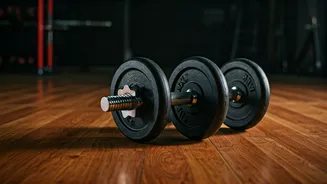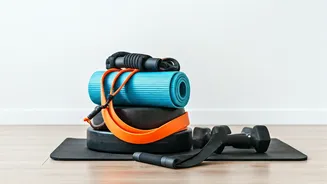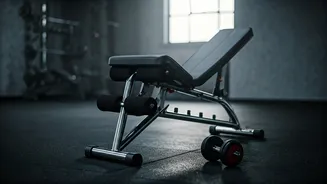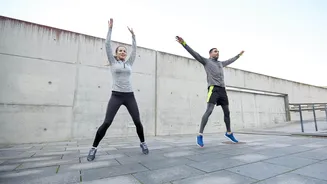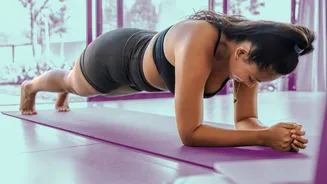What Is It?
The Bulgarian split squat, a unilateral exercise, is executed by placing one foot elevated behind you on a bench or stable surface, while the other foot remains
planted in front. This stance is maintained as you lower your body, with the front knee bending to approximately a 90-degree angle. This exercise targets the quadriceps, hamstrings, and glutes. The Bulgarian split squat significantly enhances lower body strength and muscular development by isolating each leg. Its unilateral nature also assists in rectifying muscle imbalances. Proper form is crucial; ensure your front knee aligns with your ankle and your back remains straight, to avoid injury and maximize effectiveness. The exercise demands balance and coordination, contributing to overall functional fitness and stability.
Technique Matters
Mastering the Bulgarian split squat requires attention to detail. First, position yourself in front of a bench or raised platform. Stand about two to three feet away. Extend one leg behind you and rest the top of your foot on the elevated surface. Your front foot should be far enough forward that when you descend, your front knee doesn't pass your toes. Slowly lower your body, bending your front knee until it reaches a 90-degree angle, or as far as you can comfortably go while maintaining proper form. Keep your back straight, and your core engaged throughout the movement. Focus on maintaining balance, which can be challenging at first. Push through your front heel to return to the starting position. It's important to control the descent and ascent to maximize muscle engagement. Breathing correctly, inhaling as you lower and exhaling as you push up, will also help. Start with a manageable number of repetitions and sets, gradually increasing the intensity as your strength improves. Prioritize form over the number of repetitions performed.
Key Benefits Explained
The Bulgarian split squat offers a multitude of benefits for fitness enthusiasts. One of the main benefits is its capacity to build strength and muscle in the legs and glutes. This unilateral exercise effectively targets each leg independently, promoting balanced muscular development and addressing imbalances that may exist. The elevated position emphasizes the front leg, thereby increasing the challenge. Also, the exercise enhances core stability, as it demands balance and control throughout the movement. This leads to improved athletic performance and daily functional movements. Moreover, the Bulgarian split squat increases flexibility and mobility in the hip flexors and ankles. This improved range of motion can contribute to better overall joint health. The exercise is also adaptable, as it can be performed using various weights, from bodyweight to dumbbells or barbells, making it suitable for all fitness levels. Finally, the Bulgarian split squat enhances coordination and proprioception.
Common Mistakes to Avoid
To fully leverage the benefits of the Bulgarian split squat, avoiding common mistakes is crucial. A prevalent error is allowing the front knee to extend beyond the toes. This can place undue stress on the knee joint and increase the risk of injury. Another mistake is improper positioning of the front foot, either too close or too far from the bench. This can throw off your balance and reduce exercise effectiveness. Rounding the back during the exercise is another error; it reduces core engagement and potentially strains the spine. Insufficient engagement of the core is another factor. Remember to engage your core muscles, providing stability throughout the movement. Neglecting proper breathing is also a mistake; always breathe rhythmically, coordinating your breath with the exercise. Finally, rushing through the exercise diminishes its benefits and increases the likelihood of errors. Maintain control and focus on the quality of your movement, rather than speed. Practice proper form, to enhance your fitness journey.
Integrating Into Your Routine
Incorporating the Bulgarian split squat into your workout routine requires strategic planning. Start by including it one to two times per week, allowing adequate recovery time between sessions. The ideal placement for the exercise is near the start of your leg workout. If your focus is strength, perform 3-4 sets of 6-10 repetitions per leg, using weights that challenge you. If your goal is muscular hypertrophy, aim for 3-4 sets of 10-15 repetitions per leg. Before starting, ensure a thorough warm-up to prepare your muscles and joints. This may include dynamic stretches, such as leg swings and lunges. Progress gradually by adding weight, increasing the number of repetitions, or adjusting the set as you get stronger. Mix it up with different exercises, such as deadlifts and squats, to ensure a balanced leg workout. Always listen to your body and adjust the intensity as needed. If you're new to the exercise, begin with bodyweight movements until you master the correct form. Be consistent to notice substantial improvements.
